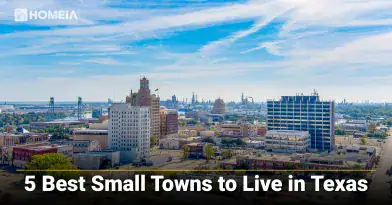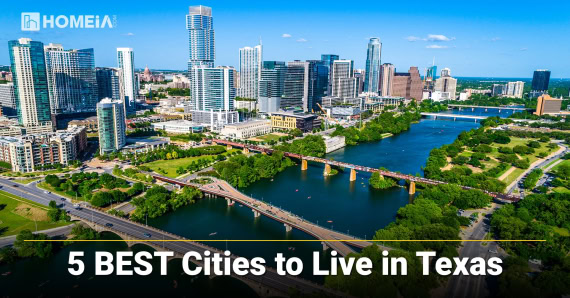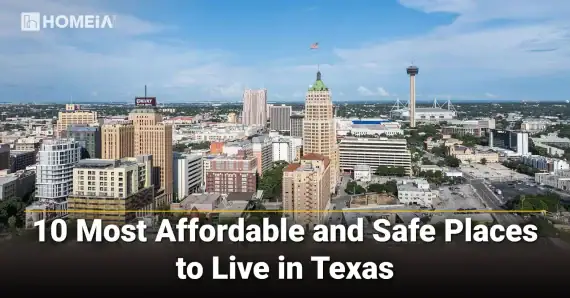Moving to Texas: THE Complete Relocation Guide to the Lone Star State and Checklist
- Local Editor:Local Editor: The HOMEiA Team
Published: Jul 15, 2025
- Category: Texas , City Living Guide
Thinking about relocating to Texas? You’re joining over 500,000 people who move to the Lone Star State each year, making Texas the #1 destination for interstate migration and out-of-state moves. With a booming economy, no state income tax, affordable housing markets, and a culture as big as its borders, Texas offers compelling reasons for families, young professionals, retirees, and businesses relocating from California, New York, and other high-cost states to call it home.
This comprehensive Texas moving guide and relocation checklist covers everything you need to know—from Texas cost of living comparisons and job market insights to step-by-step moving timelines and best cities to live in Texas. Whether you’re considering Austin’s Silicon Hills tech scene, Dallas-Fort Worth’s corporate headquarters, Houston’s energy corridor, or San Antonio‘s affordable family-friendly lifestyle, we’ll help you make an informed decision about your Texas relocation and interstate move. You’ll be ready to start saying y’all in no time!
The 10 Cheapest Places to Live in Texas (updated)
They say everything is bigger in Texas, and for good reason. From some of America’s largest and active metropolitan cities to the host of recreational activities for people of all ages across the state to the many bigger-than-life personalities who call Texas home, Texas has plenty to offer for everyone. here’s the list of 10 lowest cost of living places…
Table of Contents:
- 1. What Is It Really Like to Live in Texas?
- 2. Cost of Living & Affordability in Texas
- 3. Jobs, Economy, and Career Opportunities
- 4. Education Excellence in Texas
- 5. Texas Tax Advantages
- 6. Best Places to Live in Texas: City-by-City Guide
- 7. Planning Your Texas Move: Step-by-Step Timeline
- A. 8-12 Weeks Before: Research and Financial Planning
- B. 4-6 Weeks Before: Documentation and Logistics
- C. 2-4 Weeks-Moving Day: Final Preparations and Execution
- D. After Arrival: Essential Settlement Tasks
- => Get the Texas Relocation Guide & Checklist PDF — prepared for both Desktop and Mobile devices.
- 🚗 Vehicle Registration & Licensing in Texas
- 🗳️ Voting & Voter Registration
- 8. Settling In: Practical Essentials
- Frequently Asked Questions About Moving to Texas
1. What Is It Really Like to Live in Texas?
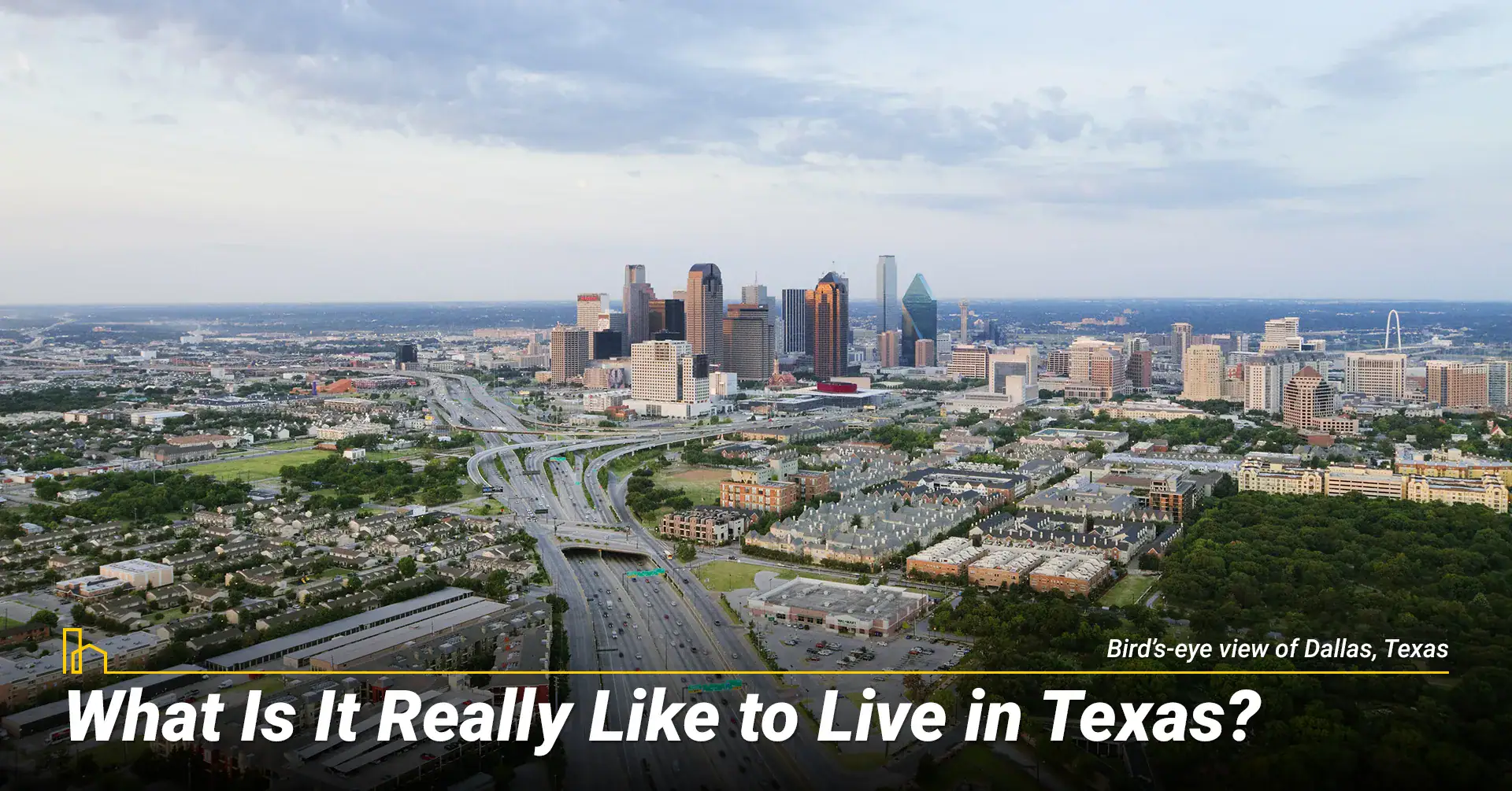
A. Texas Culture & Lifestyle
Living in Texas means experiencing authentic Southern hospitality combined with a unique melting pot of cultures that creates one of America’s most distinctive regional identities. Influences from Hispanic, Native American, European, African American, and Asian communities shape everything from language and cuisine to art, architecture, and social customs. Texans are known for their can-do it attitude, resilience, and strong sense of community—neighbors genuinely look out for each other. Newcomers relocating to Texas are welcomed warmly into established social networks.
The Texas lifestyle balances metropolitan sophistication with small-town charm in ways that few other states can match for families moving to Texas. Whether you’re living in major metropolitan areas like the Dallas-Fort Worth Metroplex or the smaller surrounding Hill Country communities, you’ll discover a distinctive blend of urban amenities and traditional values that defines modern Texas living. This unique cultural blend creates communities where tech executives and ranchers coexist comfortably, where world-class museums sit alongside authentic honky-tonk bars, and where cutting-edge innovation meets time-honored traditions that attract people moving from all states.
B. Food Scene: BBQ, Tex-Mex, and More
Texas cuisine is legendary for good reason and represents a major draw for newcomers seeking authentic culinary experiences.
Barbecue serves as a point of state pride, with brisket and ribs slow smoked to perfection using time-honored techniques passed down through generations of pitmasters. Despite the strong BBQ tradition favoring slow cooked meat, vegans and vegetarians can also easily grab a bite with new spins on classic BBQ popping up throughout the state.
Tex-Mex dishes like breakfast tacos and enchiladas have become daily staples throughout the state, while the diverse food scene constantly evolves with new global influences reflecting Texas’s multicultural heritage. The numerous taco trucks and establishments across the state offer everything from classic to unique tacos. Some of these are even being featured in national lists and in food blogs and tv shows.
From Austin’s innovative food truck culture to Dallas’s upscale dining establishments, Texas offers culinary experiences spanning every price point and taste preference. San Antonio’s River Walk provides authentic Mexican American cuisine, while Houston’s international population has created one of the nation’s most diverse restaurant scenes. The state’s agricultural abundance ensures access to fresh, local ingredients, and competitive restaurant markets keep prices reasonable even for high-quality dining experiences. You won’t go hungry in Texas!
7 Best Neighborhoods in Austin, Texas (updated)
Austin blends quirky charm, vibrant culture, and a spirit of freedom that locals love. With rapid growth and diverse neighborhoods, this guide helps you find the perfect place to call home, based on real local insight and the city’s unique mix of valor, swagger, and welcoming character….
C. Festivals, Music, and Arts
Texas is the live music capital of the world, especially Austin, creating a vibrant cultural landscape that attracts artists and music lovers from around the globe. Austin hosts internationally recognized festivals like SXSW and Austin City Limits, while communities throughout the state celebrate with rodeos, chili cook-offs, and cultural festivals that bring neighbors together. The state’s music scene encompasses country, blues, indie rock, electronic, and emerging genres, with venues ranging from intimate clubs to massive amphitheaters supporting both emerging artists and established acts. With numerous metropolitan areas across the state, many “big name” acts often make several stops throughout the state, giving you the chance to catch your favorite artist!
Beyond music, Texas cities offer world-class cultural amenities including museums, theater companies, and art galleries. Dallas boasts an impressive downtown arts district, Houston’s Museum District rivals any major American city, and Austin and San Antonio showcase many local artists throughout their cities. Smaller communities throughout the state maintain active arts councils and cultural programming that enriches local life and provides entertainment opportunities for residents of all ages and interests, too.
D. Outdoor Life & Recreation
With more than 80 state parks, Texas is a haven for outdoor enthusiasts offering year-round recreation opportunities across incredibly diverse landscapes. You can hike through rugged desert terrain in Big Bend National Park, swim and tube in the Hill Country’s crystal-clear rivers, or fish along Gulf Coast beaches that stretch for hundreds of miles. Ranching heritage remains integral to the authentic Texas experience, with wildlife watching, camping, hunting, and outdoor education programs available throughout the state.
State parks offer facilities ranging from primitive camping sites to luxury glamping experiences, with educational programs about Texas natural history, conservation efforts, and outdoor skills. The state’s massive size means outdoor enthusiasts can experience desert landscapes, pine forests, coastal wetlands, and rolling hills all within Texas borders, providing endless exploration opportunities for nature lovers and adventure seekers.
You can take a break from the heat at one of the Lone Star State’s many natural swimming areas. The Colorado river runs straight through Austin, which offers many opportunities from kayaking to boating. From lakes to the Gulf of Mexico, there is sure to be a place for you to cool off and enjoy the water!
The Pros and Cons of Living in Texas
Thinking about relocating? Understanding the pros and cons of living in Texas is essential. With no state income tax, affordable housing, and a booming job market, Texas appeals to many. However, be prepared for hot summers, regional weather extremes, and urban sprawl. Choosing the right city is key to your experience…
E. Weather & Climate
Texas weather varies significantly by region. Newcomers should prepare for diverse climate conditions throughout the state. Understanding regional weather patterns helps new residents choose appropriate locations and prepare for seasonal challenges.
| Region | Summer High | Winter Low | Annual Rainfall | Humidity | Main Weather Concerns |
| East Texas | 90-95°F | 35-45°F | 45-55 inches | High (70-80%) | Thunderstorms, flooding |
| West Texas | 95-105°F | 25-35°F | 8-20 inches | Low (30-40%) | Drought, dust storms |
| Gulf Coast | 85-92°F | 45-55°F | 40-60 inches | Very High (80-90%) | Hurricanes, flooding |
| Hill Country | 88-95°F | 30-40°F | 30-35 inches | Moderate (50-60%) | Flash floods, ice storms |
| Panhandle | 90-98°F | 20-30°F | 20-25 inches | Low (40-50%) | Tornadoes, blizzards |
Severe weather events require preparation and awareness, including thunderstorms with heavy rain and hail, tornadoes particularly in northern and central regions, and hurricanes affecting Gulf Coast areas. Emergency preparedness is essential for all residents, with weather alert systems and community preparedness programs helping residents stay safe during extreme weather events.
5 Best Places to Live in Texas: 2025
Texas is famous for its wide, open spaces, booming economy, the unique blend of urban and rural lifestyles, and delicious food. The Lone Star State has it all: rolling hills with breathtaking scenery for miles, vast deserts, and bustling metropolitan areas…
2. Cost of Living & Affordability in Texas

Texas cost of living is approximately 5% lower than the national average, making your dollar stretch further than in most other states and particularly attractive for remote workers moving to Texas. This affordability advantage, combined with Texas no state income tax policy, creates significant financial benefits for residents across all income levels. The combination of affordable housing in Texas, competitive utility rates, and tax advantages makes Texas particularly attractive for those seeking to maximize their purchasing power and quality of life compared to expensive states like California and New York.
A. Housing Market Overview
Texas housing market represents the state’s biggest affordability advantage compared to other major states, though regional variations exist throughout Texas real estate markets. The statewide median home price stands at $299,787, approximately 16% below the national median of $357,000, making Texas one of the most affordable states for homebuyers. However, the Texas housing market 2025 is currently experiencing significant adjustment with increased inventory levels and regional price variations reflecting local economic conditions and demand patterns from interstate migration.
| City | Median Home Value | % vs. National Avg | Average Rent | Days on Market | Market Trend |
| Austin | $577,400 | +29% | $2,450 | 68 | Cooling |
| Dallas | $306,959 | -14% | $2,100 | 72 | Stable |
| Houston | $265,434 | -26% | $1,850 | 78 | Buyer-Friendly |
| San Antonio | $250,675 | -30% | $1,650 | 85 | Affordable |
| Plano | $665,900 | +87% | $2,800 | 65 | Premium |
| Frisco | $599,900 | +68% | $2,650 | 63 | Growing |
| Texas Average | $299,787 | -16% | $1,995 | 75 | Adjusting |
Current Texas real estate market conditions show 123,000 listings in April 2025, representing 53% above typical levels, with homes averaging 75 days on market indicating increasingly buyer-friendly conditions for those looking at homes for sale in Texas. Austin leads major cities with median home values driven by tech industry growth and limited housing supply, while San Antonio provides the most affordable major city option for families seeking cheap places to live in Texas, making it attractive for families and retirees seeking value in the best places to live in Texas for families.
5 Best Small Towns to Live in Texas (updated)
Texas small towns attract families seeking charm, opportunity, and community. Our helpful guide highlights Fredericksburg, Dripping Springs, Boerne, Wimberley, and Brenham, sharing key facts on housing, schools, and culture to help you find the perfect place for a cozy, fulfilling Texas lifestyle and informed relocation choice…
B. Utilities and Daily Expenses
Texas utilities run about 1% higher than the national average due to climate demands and energy market structure. However, Texas’s deregulated electricity market allows residents to choose providers, potentially reducing costs through strategic shopping using comparison sites like PowerToChoose.org.
| Utility Type | Texas Average | National Average | % Difference | Notes |
| Electricity | $166/month | $137/month | +21% | Higher due to A/C usage |
| Water & Sewer | $45/month | $50/month | -10% | Municipal rates vary |
| Gas | $28/month | $35/month | -20% | Minimal heating needs |
| Garbage/Recycling | $25/month | $30/month | -17% | Competitive markets |
| Internet (60+ Mbps) | $66/month | $68/month | -3% | Deregulated options |
| Total Basic Utilities | $169/month | $183/month | -8% | Net savings |
C. Groceries and Transportation Costs
Groceries cost about 3% less than the U.S. average providing daily savings for Texas residents across all income levels. Texas sales tax exempts most groceries including essential food items for home consumption, providing additional savings on everyday necessities.
| Expense Category | Single Person | Family of 4 | % vs. National | Tax Status |
| Groceries (Essential) | $280-300/month | $800-1,000/month | -3% | Tax Exempt |
| Restaurants (Casual) | $150-200/month | $400-600/month | -5% | Taxed |
| Gas (Regular) | $120-150/month | $200-300/month | -15% | Taxed |
| Transportation (total) | $350-400/month | $500-650/month | -6% | Mixed |
Transportation costs are 6% lower than national averages though personal vehicle ownership remains essential for most residents. Car insurance averages $130–$160 monthly, while gas prices hover at $2.65–$3.00 per gallon, creating total monthly transportation costs of $350–$400 for most households.
Recommended for you
3. Jobs, Economy, and Career Opportunities

Texas economy is booming with a GDP of $2.6 trillion and projected to add 276,000 new jobs in 2025, making it an attractive destination for professionals across industries and those seeking Texas jobs for out of state workers. The state’s job growth is broad-based, led by energy, technology, and healthcare sectors that offer competitive salaries and career advancement opportunities. Texas leads the nation in business relocations and corporate headquarters moves due to its favorable business environment, skilled workforce availability, and strategic geographic location providing access to major markets for companies relocating to Texas.
A. Major Industries and Employment Sectors
Texas offers diverse career opportunities across multiple high-growth industries with competitive compensation packages that attract professionals from across the nation and internationally.
| Industry | Key Employers | Average Salary ($) | Job Growth Rate | Major Locations |
| Energy | ExxonMobil, Chevron, Shell, BP | $110,000 | 8.5% | Houston, Midland |
| Technology | Dell, Tesla, Oracle, Apple, Microsoft | $125,000 | 12.3% | Austin, Dallas |
| Healthcare | MD Anderson, HCA, Baylor Scott & White | $85,000 | 15.2% | Houston, Dallas |
| Aerospace | NASA, Lockheed Martin, Boeing | $95,000 | 6.8% | Houston, Fort Worth |
| Financial Services | Charles Schwab, Fidelity, American Express | $88,000 | 9.1% | Dallas, Austin |
| Manufacturing | Toyota, Samsung, AT&T | $72,000 | 7.4% | San Antonio, Dallas |
The energy sector offers opportunities ranging from traditional oil and gas to renewable energy development, with positions in upstream exploration, downstream refining, and emerging clean energy technologies. Technology companies provide roles in software development, cybersecurity, data science, and artificial intelligence, while healthcare expansion reflects aging population demographics and medical advancement creating opportunities across clinical care, research, and administration.
15 Best Cities for Families in Texas
There are many employment opportunities throughout the state and many enjoyable communities to call home. We’ve compiled a list of 15 cities that rank high in education, affordability, and safety—areas of interest for many potential homeowners…
B. Metropolitan Job Markets
- Austin’s technology sector continues expanding with major companies establishing significant operations and startup ecosystems thriving throughout the region, making it one of the best cities in Texas for tech workers. The city’s “Keep Austin Weird” culture attracts creative professionals seeking work-life balance, while major tech companies including Apple’s major campus expansion, Google’s significant local presence, and Tesla’s Gigafactory create diverse employment opportunities for those moving to Austin Texas for jobs. Texas no state income tax significantly benefits high-tech salaries, making Austin competitive with Silicon Valley while offering lower living costs for remote workers and tech professionals relocating to Texas. As the center of Texas’ state government, there are also many opportunities for those looking to enter politics.
- The Dallas-Fort Worth Metroplex serves as a major corporate headquarters hub hosting numerous Fortune 500 companies and business services operations. The region’s central location provides access to national markets, while excellent transportation infrastructure through DFW International Airport supports business operations and international connectivity. Major employers include AT&T, American Airlines, Texas Instruments, and Southwest Airlines, creating opportunities across telecommunications, aviation, technology, and logistics.
- Houston leverages its position as the energy capital while diversifying into healthcare, aerospace, and international trade. The energy sector provides high-paying opportunities across traditional oil and gas, renewable development, and energy finance. Texas Medical Center offers healthcare opportunities as the world’s largest medical complex, while NASA Johnson Space Center anchors the aerospace industry with engineering and research positions.
12 Key Factors to Know When Living in Dallas, Texas
The city is the 9th largest in the United States. Dallas Texas is a little bit country, a little bit rock ’n’ roll, and a whole lot of history, arts, culture and business in the center of the fourth-largest metropolitan statistical area in the United…
4. Education Excellence in Texas
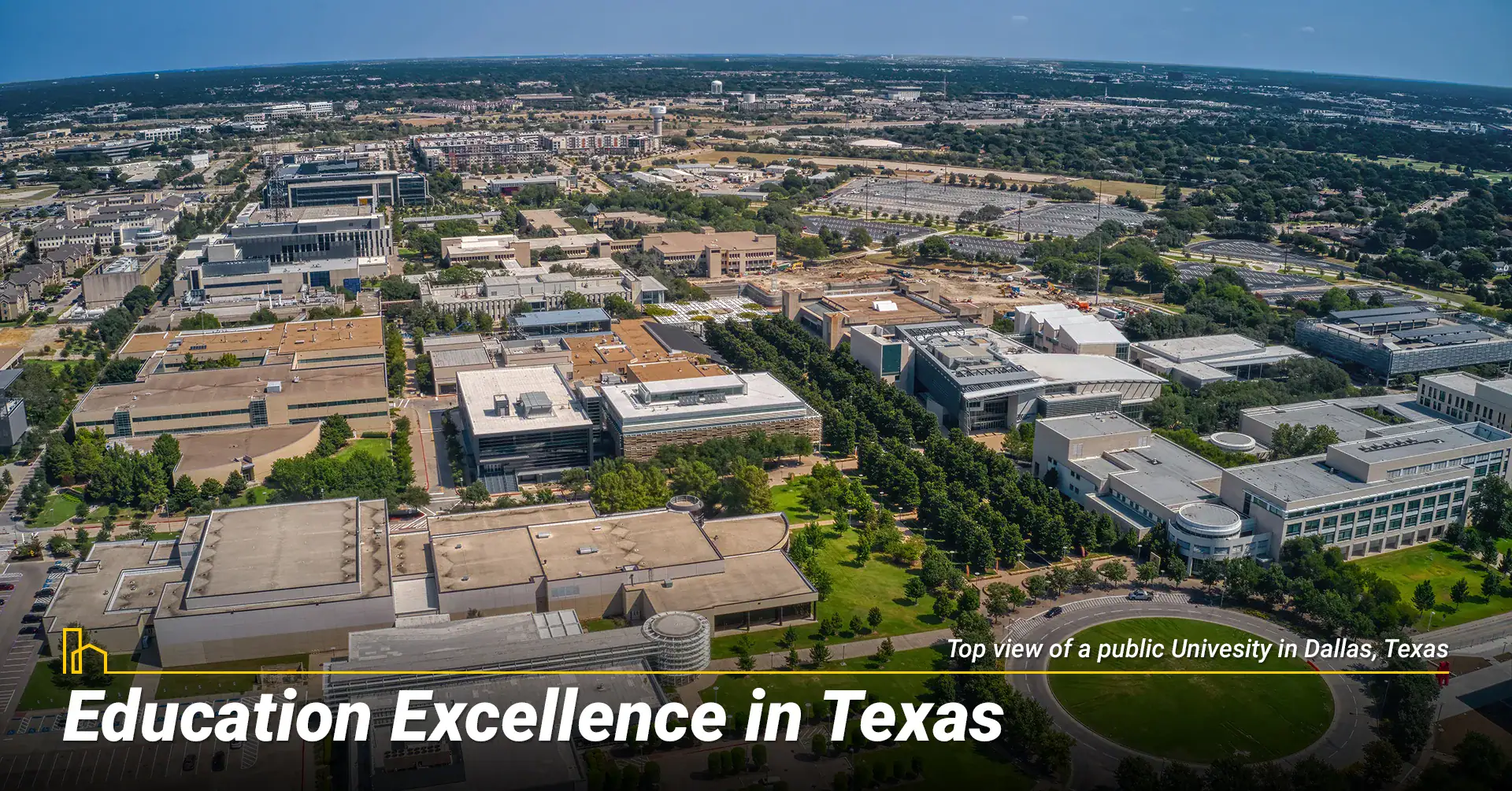
Texas offers diverse educational opportunities from top-rated public school districts to prestigious universities, making the state attractive for families prioritizing education quality and professionals seeking continued learning opportunities. Texas students outperform national averages in key academic subjects, with 4th grade math scores of 241 compared to the national average of 237, while Texas English Learners lead the nation in 8th grade reading and math performance.
A. Public School System Performance
Exceptional school districts throughout the state consistently rank among the nation’s best, providing excellent educational foundations for students across diverse communities.
| School District | Location | Students | Graduation Rate | College Readiness | Rating |
| Southlake Carroll ISD | Dallas Area | 8,200 | 99.1% | 94% | Exemplary |
| Eanes ISD | Austin Area | 8,500 | 97.8% | 89% | Exemplary |
| Plano ISD | Dallas Area | 54,000 | 96.2% | 87% | Recognized |
| Klein ISD | Houston Area | 53,000 | 95.1% | 82% | Recognized |
| Frisco ISD | Dallas Area | 68,000 | 97.5% | 88% | Exemplary |
| Highland Park ISD | Dallas Area | 7,000 | 98.9% | 91% | Exemplary |
These districts benefit from substantial community support, competitive teacher salaries, comprehensive facilities, and advanced technology integration. Extracurricular excellence includes nationally recognized athletics programs, award-winning music and arts programs, and academic competition teams achieving state and national honors.
B. Higher Education Institutions
Texas hosts world-renowned universities that contribute to workforce development and research advancement. The University of Texas at Austin ranks as a top public university nationally with excellent engineering and business programs, while Texas A&M University leads in agricultural and engineering programs with strong military tradition. Rice University operates as an elite private research institution with small class sizes and prestigious programs, and community college systems provide affordable pathways to four-year degrees and career training. State universities are scatted across the state with programs and campus cultures catering to everyone.
Recommended for you
5. Texas Tax Advantages
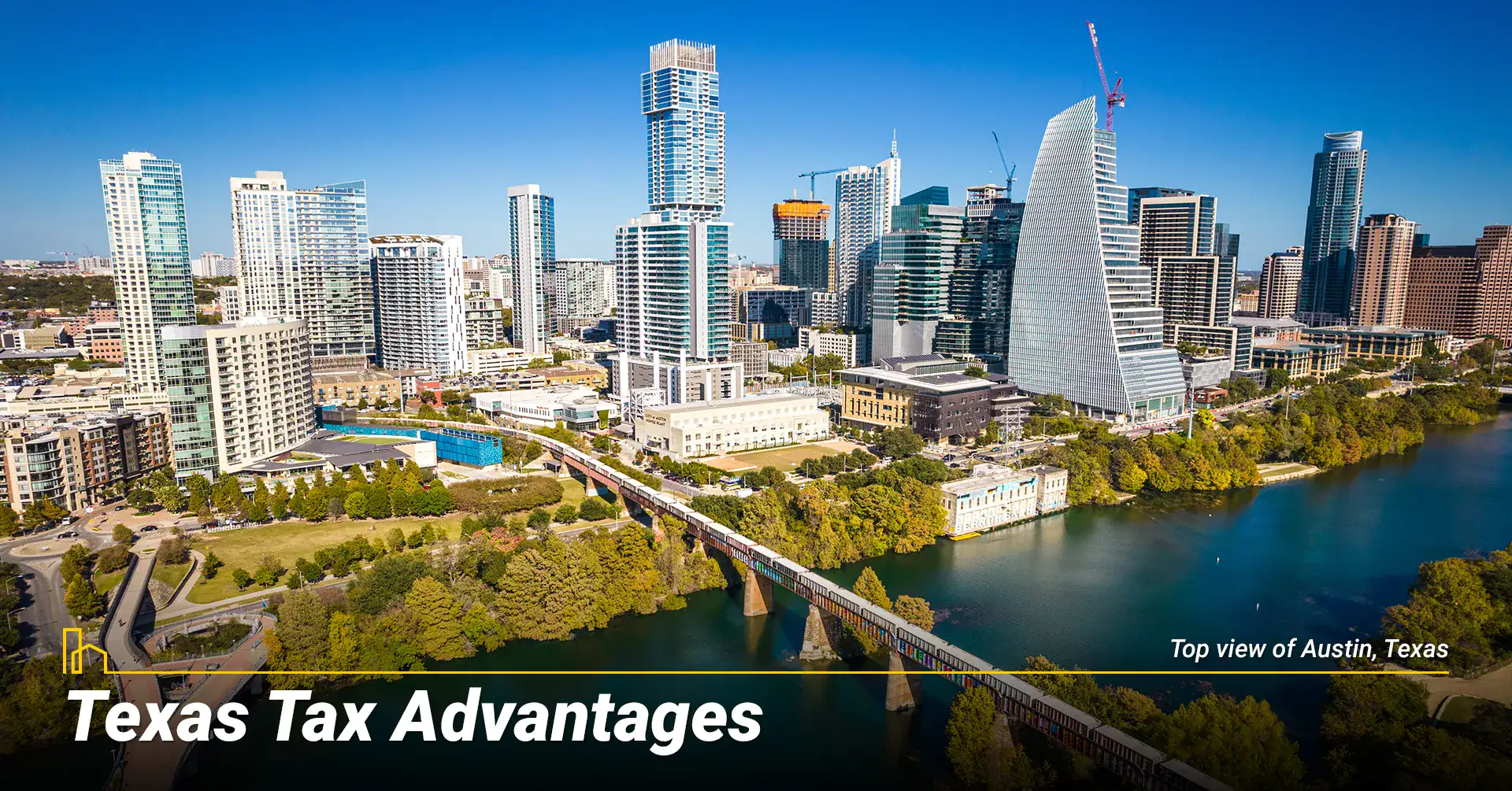
Texas is one of only seven states with no personal income tax, providing major financial benefits for residents and making it particularly attractive for high earners who would face significant state income taxes elsewhere. This Texas tax advantage means more take-home pay for working professionals, greater retirement income security for seniors, and improved business profitability for entrepreneurs, making Texas vs California taxes and Texas vs New York taxes comparisons highly favorable for most income levels.
A. Tax Structure Overview
No state income tax applies to any earnings, creating substantial take-home pay advantages for Texas residents across all income levels.
| Tax Type | Texas Rate | National Average | What’s Taxed | Exemptions |
| State Income Tax | 0% | 5.1% | None | All income exempt |
| Property Tax | 1.69% | 1.07% | Real estate, vehicles | Homestead, senior, veteran |
| State Sales Tax | 6.25% | 6.35% | Most goods/services | Groceries, medicine |
| Local Sales Tax | 0-2% | 1.2% | Same as state | Varies by locality |
| Corporate Tax | 0.375-0.75% | 6.2% | Business revenue | Small business exemption |
B. Financial Impact Analysis
High earners save thousands annually compared to high-tax states like California and New York, often saving $5,000-$15,000 annually in state income taxes depending on income levels, making Texas attractive for California to Texas moves and New York to Texas relocations. Retirees keep more of their fixed incomes from pensions, 401(k) distributions, and Social Security benefits, all of which remain untaxed at the state level, making Texas a top retirement destination. Property taxes are higher than national averages but homestead exemptions reduce burdens for primary residences, and most residents experience net tax savings despite higher property and sales tax rates when comparing Texas vs other states taxes.
8 Key Steps to Buy a Mobile Home in Texas
Texas is a popular place to own a mobile home—and to manufacture them! If mobile home life is for you, you’ll have to do some research before you buy. We’ll help you learn the ins and outs of buying a mobile home in Texas so you’ll have a new place to hang your hat in no time…
6. Best Places to Live in Texas: City-by-City Guide
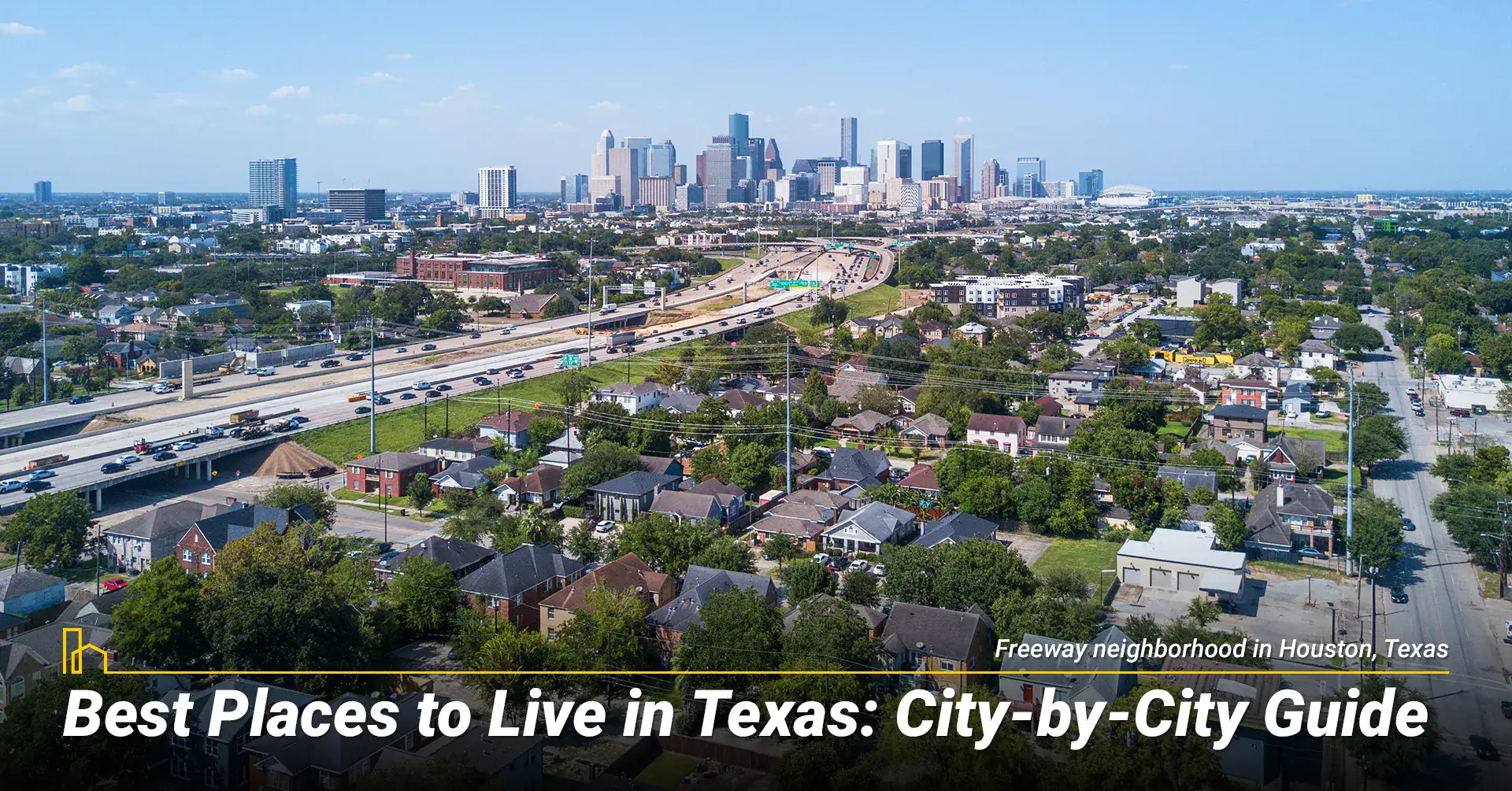
A. Austin: Technology Innovation and Cultural Hub
Austin combines technological innovation with cultural vibrancy earning its reputation as the “Live Music Capital of the World” while attracting young professionals and creative types seeking dynamic urban living, making it one of the best places to live in Texas for young adults. The thriving technology industry includes major employers creating thousands of jobs, while the vibrant music and arts scene features over 250 live music venues, internationally recognized festivals like SXSW and Austin City Limits, and strong film and digital media industry presence.
Austin advantages include strong job market with 2.9% unemployment, University of Texas providing educational and cultural opportunities, excellent restaurants and food truck scenes, outdoor recreation including Lady Bird Lake and Hill Country access, and generally young, educated population creating dynamic social opportunities for those moving to Austin for lifestyle reasons. Considerations include higher housing costs at 29% above national average, rapid population growth creating infrastructure challenges, traffic congestion during peak hours, new construction projects, and limited public transportation outside downtown areas. As a cultural center and the state capital, tourists flock to the city often producing random spurts of traffic and crowds.
B. Dallas-Fort Worth: Business Excellence and Suburban Living
The Dallas-Fort Worth Metroplex offers exceptional business opportunities and family-friendly suburban communities with excellent schools and major corporate headquarters. The region’s major corporate presence creates diverse job opportunities, while excellent suburban communities like Plano, Frisco, Allen, and McKinney offer top-rated schools, modern infrastructure, and family amenities.
DFW advantages include moderate housing costs relative to income opportunities, DFW International Airport providing global connectivity, cultural attractions including world-class museums and performing arts, professional sports teams in all major leagues, and diverse neighborhoods accommodating various lifestyle preferences. Considerations include urban sprawl requiring significant commuting, summer heat and humidity, traffic congestion during rush hours, and tornado activity requiring weather awareness.
Is it Worth Investing in Texas Real Estate in 2025?
Should you be concerned, or is it still worth investing in Texas real estate this year? Below, we’ll cover some of the things you need to know to answer that question. This advice will help you make the best choices so your profits can be as high as possible.
C. Houston: Energy Capital and Medical Excellence
Houston leverages its position as the energy capital while diversifying into healthcare, aerospace, and international trade as America’s fourth-largest city. Strong energy sector employment spans upstream exploration, downstream refining, renewable energy development, and energy trading, while world-class medical facilities centered around Texas Medical Center create healthcare employment opportunities. Houston also has a growing art scene.
Houston advantages include affordable housing at 26% below national average, cultural diversity and international cuisine reflecting global population, space exploration heritage through NASA Johnson Space Center, Port of Houston creating international trade opportunities, and museums and arts including Museum District attractions. Considerations include hurricane risk requiring emergency preparedness, high humidity throughout much of the year, traffic congestion in major corridors, and flooding potential during heavy rain events.
D. San Antonio: Affordability and Cultural Heritage
San Antonio combines historic charm with modern amenities at the most affordable cost among major Texas cities, appealing to families, retirees, and those seeking cultural richness without metropolitan expenses, making it one of the cheapest places to live in Texas. As the most affordable major Texas city with housing costs 30% below national average, San Antonio offers excellent value across income levels and ranks among the best places to live in Texas for families on a budget.
Advantages include rich cultural heritage including The Alamo and historic missions, River Walk entertainment and dining, growing technology sector through “Silicon Hills” development, military presence providing stable employment, family-friendly atmosphere with year-round community events, and excellent Mexican and Tex-Mex cuisine making it attractive for those seeking affordable living in Texas. Considerations include lower average wages compared to Austin and Dallas, intense summer heat with high humidity, limited public transportation outside downtown, and tourist crowds in popular areas.
Recommended for you
7. Planning Your Texas Move: Step-by-Step Timeline
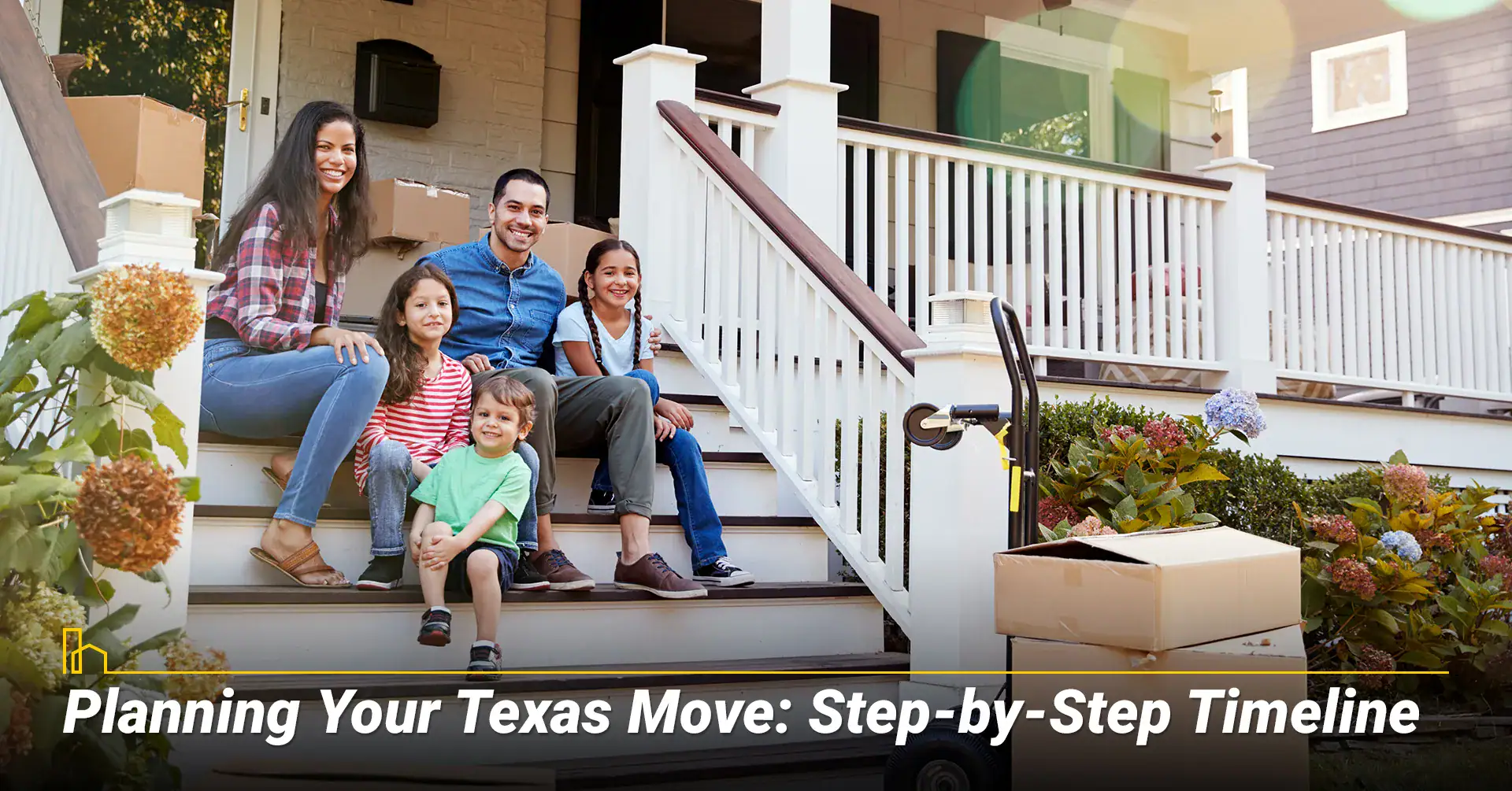
A. 8-12 Weeks Before: Research and Financial Planning
Comprehensive research forms the foundation of successful Texas relocation and interstate moving planning. Investigate specific Texas cities matching your lifestyle and career goals, research neighborhoods for safety, schools, and amenities, and visit potential areas in person if possible. Calculate complete moving to Texas costs including professional services, temporary lodging, utility deposits, and emergency funds for your long distance move to Texas.
| Type of Move | 1 Bedroom | 2-3 Bedrooms | 4-5 Bedrooms |
| DIY/Truck Rental | $500–$2,400 | $790–$4,350 | $1,400–$4,800 |
| Moving Container | $800–$2,700 | $1,200–$4,800 | $2,200–$7,900 |
| Full Service | $1,300–$3,900 | $1,600–$8,500 | $3,200–$14,200 |
B. 4-6 Weeks Before: Documentation and Logistics
Gather essential documents including birth certificates, medical records, school transcripts, insurance policies, tax returns, and financial records needed for establishing Texas residency. Begin packing non-essential items systematically, schedule utility disconnections and connections, submit USPS address changes, and arrange pet transportation if needed for your interstate relocation to Texas.
C. 2-4 Weeks-Moving Day: Final Preparations and Execution
Complete final arrangements including confirming moving company details, preparing essentials boxes for first night needs, cleaning current home, and disposing of hazardous materials properly. On moving day, conduct thorough walkthroughs, record final utility readings, and maintain organization with important documents during travel.
D. After Arrival: Essential Settlement Tasks
Complete immediate requirements including verifying utility connections, registering vehicles within 30 days, applying for Texas driver’s license within 90 days, registering to vote, enrolling children in school, and updating addresses with financial institutions and service providers. These Texas residency requirements are essential for establishing legal residence and accessing state benefits.
=> Get the Texas Relocation Guide & Checklist PDF — prepared for both Desktop and Mobile devices.
🚗 Vehicle Registration & Licensing in Texas
Vehicle Registration
Requirement | Details | Cost/Timeline |
|---|---|---|
| Registration Deadline | Register within 30 days of becoming a Texas resident. | Within 30 days or penalties apply |
| 2025 Changes | No safety inspections for non-commercial vehicles; $7.50 replacement fee added to all registrations. | Effective January 1, 2025 |
| Emissions Testing | Required for vehicles 2-24 years old in 17 counties: Brazoria, Collin, Dallas, Denton, El Paso, Ellis, Fort Bend, Galveston, Harris, Johnson, Kaufman, Montgomery, Parker, Rockwall, Tarrant, Travis, Williamson. Bexar county will join November 2026. | $25.50 at station + $2.50 to TxDMV |
| Insurance Requirements | Minimum liability coverage required | $30,000/$60,000/$25,000 |
| Out-of-State Vehicles | Bring title/registration, insurance proof, and residency documents to the county tax office. | $90 New Resident Fee OR 6.25% sales tax (whichever higher) |
| Electric Vehicle Fees | Additional fees for EVs under 10,000 lbs. | $200 annual (existing) / $400 initial two-year (new) |
| Base Registration Fees | Standard fees for all non-commercial vehicles | $50.75 + $1 TexasSure + $7.50 replacement = $59.25 minimum |
| New Vehicle Fees | Initial registration for brand new vehicles | $16.75 inspection replacement fee (covers two years) |
Driver’s License Transfer
Requirement | Details | Timeline/Notes |
|---|---|---|
| Grace Period | May legally drive on current valid out-of-state license | Up to 90 days from move date |
| Transfer Deadline | Must obtain Texas DL after grace period | Within 90 days to avoid penalties |
| Residency Proof | Two documents proving Texas residency required | One must show 30+ days residence (waived for valid license transfers) |
| Testing Requirements | No knowledge or driving exams if current license is valid and unexpired | Reciprocity agreements with France, Germany, South Korea, UAE, and Taiwan |
| Required Documents | Must bring with you to the DPS office | Identity proof, lawful presence, SSN, Texas residency, vehicle registration (new residents), insurance verification |
| License Surrender | Must surrender out-of-state license | Required at time of application |
🗳️ Voting & Voter Registration
Current Registration Requirements
Requirement | Details | Timeline |
|---|---|---|
| Registration Deadline | Complete voter registration before elections | At least 30 days before any election |
| Registration Methods | Multiple options available | Online, at DPS during license transactions, and paper forms to county offices |
| Eligibility Criteria | Must meet all requirements | U.S. citizenship (sworn affidavit), Texas county residency, age 18 by Election Day, no disqualifying felonies, mental competency |
Pending Legislative Changes
Legislation | Status | Requirements | Impact |
|---|---|---|---|
| Federal SAVE Act | Passed the U.S. House in April 2025, pending in Senate | Documented proof of citizenship (passport, birth certificate, naturalization certificate) for federal elections | Could affect 21+ million Americans lacking easy access to citizenship documents |
| Texas Senate Bill 16 | Pending in Texas Legislature | Proof of citizenship for ALL elections (state, local, presidential) | Would create “federal-only” voter rolls for those without citizenship proof; could impact existing registered voters who registered via mail or voter drives |
21 Affordable Things to Do in Midland, Texas
Midland offers many fun and affordable attractions for its residents. We took a closer look at these activities and put together a list of 21 popular, affordable things to do in Midland, Texas…
8. Settling In: Practical Essentials

A. Utilities and Services Setup
Texas’s deregulated electricity market allows provider choice through comparison sites like PowerToChoose.org. Municipal services including water, gas, and trash are managed by local governments, while internet options vary by region and provider availability.
| Service Type | Provider Options | Setup Process | Typical Costs |
|---|---|---|---|
| Electricity | Multiple competitive providers | Compare rates online, sign up | $100-200/month |
| Water/Sewer | Municipal utility department | Contact local office | $30-60/month |
| Internet | AT&T, Spectrum, Xfinity, others | Schedule installation | $50-100/month |
| Trash/Recycling | City/county waste management | Automatic with residence | $15-35/month |
B. Legal Requirements and Documentation
Vehicle registration and driver’s license requirements are strictly enforced with specific deadlines and documentation requirements that new residents must understand and follow.
| Requirement | Deadline | Location | Required Documents | Estimated Cost |
| Vehicle Inspection | Before registration | Certified stations | Current registration, insurance | $25-50 |
| Vehicle Registration | 30 days | County tax office | Inspection, insurance, title, ID | $75-200 |
| Driver’s License | 90 days | DPS office | ID, SSN proof, residency proof | $25-35 |
| Voter Registration | No deadline | DPS or online | Same as driver’s license | Free |
3 Most Affordable and Safe Neighborhoods to Live in San Antonio, Texas
With an advantageous tax structure, a low cost of living, and a warm, diversified climate, San Antonio blends financial attractiveness and cultural life, making it a dynamic and cheap Texas destination…
C. Community Integration and Social Networks
Build your Texas social network by actively participating in local events, organizations, and activities matching your interests and values. Join local clubs based on hobbies, professional interests, or family needs, attend neighborhood association meetings and community festivals. Utilize online community resources including social media groups and neighborhood apps like Nextdoor. Many neighborhoods are now also on Facebook and make use of the private group function, allowing neighbors to meet and discuss issues or questions that they may have.
Introduce yourself to neighbors and participate in neighborhood activities like block parties and holiday celebrations. Texas culture emphasizes neighborly relationships and community support, so genuine efforts to connect with neighbors are typically welcomed warmly and help accelerate your integration into local community life.
Summary: Ready to make your move to Texas? This comprehensive Texas relocation guide provides the foundation for successful interstate moving to the Lone Star State. From understanding Texas cost of living and job markets to navigating practical moving steps and finding the best Texas cities for your needs, Texas offers outstanding opportunities for individuals, families, and businesses seeking economic growth, affordable living, and a distinctive quality of life that’s uniquely Texan.
Whether you’re planning a California to Texas move, New York to Texas relocation, or moving from any state to Texas, the Lone Star State welcomes you with open arms and endless possibilities for starting this next chapter in your life.
Recommended for you
Frequently Asked Questions About Moving to Texas
1. Do I Need a Car in Texas?
Yes, you absolutely need a car in most Texas areas. Texas is a massive state with limited public transportation outside major urban centers like Dallas, Houston, and Austin. In some areas, biking is a possible mode of transportation, but the weather and size of Texas limits this option as well. Most Texans rely on personal vehicles for commuting, errands, and recreational travel, with rural and suburban areas particularly requiring reliable transportation for accessing employment, healthcare, shopping, and essential services. This is important to consider when planning your cost of moving to Texas.
2. How Safe Is Texas?
Safety in Texas varies by location and community, much like any large state with diverse urban, suburban, and rural areas. Many suburbs and small towns maintain low crime rates and strong community bonds, while urban areas contain neighborhoods ranging from very safe to requiring greater caution. Research crime statistics for specific areas and consult with locals and law enforcement before choosing neighborhoods.
3. What Are the Biggest Challenges for Texas Newcomers?
Climate adjustment represents the most common challenge for newcomers, particularly those relocating from cooler or less humid regions and those moving from northern states to Texas. Texas summers can be intensely hot with high humidity, requiring lifestyle adjustments and quality air conditioning. Understanding Texas property tax systems can be confusing since rates are higher than many states, though overall tax burden often remains lower due to no income tax. Building new social networks takes time and effort, though Texans’ welcoming nature helps accelerate integration for out of state movers.
4. How Much Money Should I Budget for Moving to Texas?
Moving to Texas costs vary significantly based on distance traveled, household size, moving method selected, and timing of your interstate move. Budget categories should include professional long distance moving services ranging from $800 to $14,200, utility deposits and connection fees, vehicle registration and driver’s license fees, temporary lodging if needed, and emergency funds for unexpected transition expenses when relocating to Texas from another state. Texas is also home to many toll roads. It might be wise to invest in a toll sticker before your move to make travel easier. This would only add about $20 to your moving expenses.
5. Is Texas Really Gun-Friendly?
Gun ownership is common in Texas due to strong cultural traditions rooted in frontier heritage, hunting culture, and rural traditions. However, not everyone owns firearms, and many residents don’t carry firearms daily. Texas gun laws include background check requirements for licensed dealer purchases, training requirements for concealed carry permits, and regulations about where firearms can be carried, with cultural emphasis on responsible ownership through safety education and legal compliance.
Important Things to Know When Buying A House in Texas
In this guide, we’ll walk you through the ins and outs of purchasing a home in the Lone Star State, paying particular attention to real estate in Monticello, Fort Worth. Ready to discover what makes Texas a fantastic place to live and how to find your perfect spot in this vast and varied real estate market? Let’s get started!..
6. What’s the Weather Really Like in Texas?
Texas weather varies dramatically by region due to the state’s massive size and diverse geography. Western areas experience arid, desert-like conditions, while Gulf Coast regions deal with high humidity year-round. Summers are hot statewide, often exceeding 90°F with some areas reaching over 100°F, while winters range from mild in the south to occasionally freezing in the north. Severe weather including thunderstorms, tornadoes, and hurricanes requires preparation and emergency planning. If you live near the coast, it might be wise to invest in hurricane insurance.
7. What Steps Must I Take After Moving to Texas?
Essential legal requirements include registering your vehicle within 30 days, applying for a Texas driver’s license within 90 days, and updating voter registration. Practical setup tasks include establishing utility services, enrolling children in school, updating pet vaccinations and registration, and changing locks for security. Administrative updates should include notifying banks, insurance companies, and other service providers of address changes. Make sure to also start searching for new doctors, too. Due to the high influx of migration, you may need to wait a month before seeing a medical practice.
8. What Are the Pros and Cons of Texas’s No Income Tax?
The Texas no state income tax advantage allows residents to keep significantly more of their paychecks, particularly benefiting higher earners who would face substantial state taxes elsewhere, making Texas vs California income tax and Texas vs New York income tax comparisons highly favorable. Texas compensates through higher property taxes funding local services and sales taxes on most purchases except essential groceries. Most residents experience net tax savings compared to high-tax states, though property owners should budget appropriately for higher property taxes when considering the true cost of living in Texas.
9. Do Texans Really Say “Y’all” and Drink Sweet Tea?
Absolutely! “Y’all” is the standard way to address groups throughout Texas, used by residents regardless of background or education level. Sweet tea remains a staple at restaurants and family gatherings, but Dr. Pepper and Big Red rival that southern staple.
Regional characteristics like respectful use of “sir” and “ma’am” demonstrate courtesy and respect, but they are not required. While it is not a requirement to own a pair of cowboy boots, you cannot go wrong with having a good pair to break out of the closet.
The Cost of Living in California vs Texas (Updated)
Both California and Texas have not only the largest populations but the largest habitable landmass of any of the U.S. states. This means there are not a lot of statements that can be made which represent either state in totality. We’ll let you know here the general cost factors to consider when making a decision to relocate to either state…
Table of Contents:
- 1. What Is It Really Like to Live in Texas?
- 2. Cost of Living & Affordability in Texas
- 3. Jobs, Economy, and Career Opportunities
- 4. Education Excellence in Texas
- 5. Texas Tax Advantages
- 6. Best Places to Live in Texas: City-by-City Guide
- 7. Planning Your Texas Move: Step-by-Step Timeline
- A. 8-12 Weeks Before: Research and Financial Planning
- B. 4-6 Weeks Before: Documentation and Logistics
- C. 2-4 Weeks-Moving Day: Final Preparations and Execution
- D. After Arrival: Essential Settlement Tasks
- => Get the Texas Relocation Guide & Checklist PDF — prepared for both Desktop and Mobile devices.
- 🚗 Vehicle Registration & Licensing in Texas
- 🗳️ Voting & Voter Registration
- 8. Settling In: Practical Essentials
- Frequently Asked Questions About Moving to Texas
HOMEiA is a city guide site where visitors can find detailed information about communities of interest. HOMEiA’s City Guides, created in partnership with local writers and editors, are curated lists of the best, safest, and most affordable places to live. The guides feature the HOMEiA Score, a proprietary index that rates communities on such factors as housing costs, education, employment, etc.
HOMEiA.com aims to be the premier site for people planning to relocate, providing them with insightful content and connecting them with skilled real estate professionals.
We also empower real estate professionals to establish or strengthen their web presence by highlighting their experience, knowledge and achievements. If you’re selected to join our list of certified real estate professionals, you will distinguish yourself from your peers — and earn HOMEiA’s support.
If you believe in HOMEiA’s mission, please share our website with others.
Table of Contents:
- 1. What Is It Really Like to Live in Texas?
- 2. Cost of Living & Affordability in Texas
- 3. Jobs, Economy, and Career Opportunities
- 4. Education Excellence in Texas
- 5. Texas Tax Advantages
- 6. Best Places to Live in Texas: City-by-City Guide
- 7. Planning Your Texas Move: Step-by-Step Timeline
- A. 8-12 Weeks Before: Research and Financial Planning
- B. 4-6 Weeks Before: Documentation and Logistics
- C. 2-4 Weeks-Moving Day: Final Preparations and Execution
- D. After Arrival: Essential Settlement Tasks
- => Get the Texas Relocation Guide & Checklist PDF — prepared for both Desktop and Mobile devices.
- 🚗 Vehicle Registration & Licensing in Texas
- 🗳️ Voting & Voter Registration
- 8. Settling In: Practical Essentials
- Frequently Asked Questions About Moving to Texas





